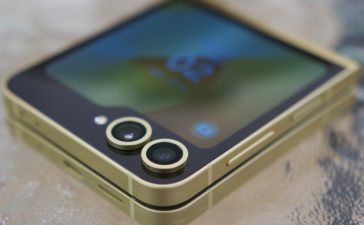It might only feel like yesterday that the new iPhone 15 was released, but experts have already begun to image the phones of the future.
Using AI imaging, Mobiles.co.uk has predicted five different ways that smartphones might develop in the future
From flexible phones to self-repairing devices, your iPhone may one day look and feel a lot different.
While some of the ideas might sound like Star Trek props, the experts say these technologies could be just around the corner.
So, do you think these ideas are the future of phones, or are they doomed to die on the drawing board?

Experts have teamed up with AI imaging tools to predict how your phone may look in the future
Using a combination of the AI tools Midjourney, Dalle3, and Adobe Firefly experts have been able to create images of what your phone might look like in the future.
The image generators were asked to create a range future phones based on various features and sustainable changes that are considered likely.
Amrit Chatha, mobile expert and Mobiles.co.uk said: ‘Looking into the future of the mobile phone industry, it is exciting to consider the possibilities for handsets to become more sustainable.
‘From solar-powered charging capabilities, to more robust and adaptable exterior designs, smartphones could change drastically over the next few years to cater to environmental needs.’
1. Flexible materials
One futuristic technology that is already on its way is the flexible phone.
Folding phones such as the Motorola Razr Plus already make use of some flexible materials to open and close a large touchscreen.
However, flexibility is currently restricted to limited parts of the screen.
According to AI, the phones of the future will one day be made completely flexible to ‘create a phone that’s as adaptable as you are’.
Sustainability consultant Jennifer von Walderdorff told MailOnline that this tech might soon be on its way.

Experts say that bendy screens are not just cool but also make phones more durable and less likely to shatter when dropped
Ms Walderhorff said: ‘Regarding flexible materials, with the rollout of flexible organic light-emitting diodes, this tech is widely available and some manufacturers are investing deep into it.’
The expert’s prediction of a future phone is not far from what has already been proposed by some manufacturers.
Recently, Motorola unveiled a concept for a foldable phone that can wrap around your wrist.
Dubbed the world’s first wearable smartphone, the device features a seemingly conventional 6.9-inch full HD+ phone screen that can be bent into any shape.
Ms Walderhorff says that flexible phones like this ‘make the device more robust, meaning they should last longer’.

Motorola has already unveiled a flexible phone that bears a striking resemblance to the AI-generated images created by experts
2. Solar powered charging
In the future we won’t just use our phones differently, we’ll power them differently too.
The experts say that charging your phone might one day seem as old-fashioned as a wired-in landline seems today.
Ms Walderdorff said: ‘As a renewable energy source, solar power is virtually limitless, and we are already seeing so much innovation, with items that can fit in your pocket.’
Hikers and backpackers will already be quite familiar with the range of portable solar chargers that can support devices for days away from a plug socket.
However, we are still a ways off from having solar panels built into our phones like the experts and AI imagine.

Running out of power might be a thing of the past as experts predict our phones might soon be able to charge on the go using the power of the Sun

Kyocera revealed a solar-powered phone in 2016 that could create one minute of call time for every three minutes the screen was in the sun
In 2016, the Japanese phone maker Kyocera announced that it had developed a phone that charges in the sunlight.
The device worked by installing a photovoltaic layer in the screen which could supposedly get a minute of call time for every three minutes in the sun.
However, since most people tend to keep their phones in their pockets, the design never caught on.
Improvements to batteries and solar panels could make the tech viable if they could charge fast enough during brief exposures to the sun.
However, Ms Walderdorff is confident that the growing demand for renewable power will push development of solar technology forward.
She said: ‘As the demand for renewable energy grows, the adoption may proportionally increase.’
3. Self-repair technology
Everyone knows the pain of dropping your phone and seeing that once pristine glass turn into a spiderweb of cracks.
Breaking your phone is not only annoying but also costly for both you and the environment.
Instead of shelling out for replacement parts or even a replacement phone, experts say the phones of the future may be able to fix themselves.
‘Manufacturing new devices and replacement parts uses a lot of energy and fossil fuels, so self-repairing phones would be a huge step forward in smartphone sustainability,’ Ms Walderdorff said.
Possibly the most futuristic technology on the list, Ms Walderdorff also points out that ‘it would be safe to say screen crack detection, as well as self-repair tech, is still in R&D for mass production.’

While it might be science-fiction for now, experts say that your phone could one day fix itself using ‘self-healing bio-plastic’

Just like something out of the Terminator, metal ‘skin’ that can self-repair could one day be used in phones to expand their lifespan
However, this science-fiction technology might not be as far away as you might think.
This year, scientists from Stanford University developed a synthetic skin that can meld back together using heat and magnets.
The skin is made of silicone and polypropylene glycol materials that stretch like human skin without tearing, while magnetic properties allow the skin to self-align.
Co-author Chris Cooper, a PhD candidate, said: ‘We’ve achieved what we believe to be the first demonstration of a multi-layer, thin film sensor that automatically realigns during healing.
‘This is a critical step toward mimicking human skin, which has multiple layers that all re-assemble correctly during the healing process.’
Using this kind of technique scientists might one day be able to create phone materials that repair themselves over time.
4. Sustainable materials
If waiting for self-healing phones seems like too much of a long shot, then the next best solution is to improve the phones we have.
As we work towards a more climate-friendly future, experts say that our phones will start to use more sustainable resources.
Smartphones have a big impact on the world’s resources as they take large amounts of rare minerals like cobalt to produce.
Over 70 per cent of the world’s cobalt is mined in the Democratic Republic of Congo where child labour and appalling conditions are common.
Ms Walderdorff said: ‘The development of new materials with improved environmental performance can reduce the industry’s current reliance on non-renewable resources.
However, she also says that the sustainable development of electronics is made difficult by the need for high-performance materials.

According to the experts, phones might soon ditch the glass and metal look that is currently popular in favour of more sustainable options

Devices like the Fairphone 4 use a modular design to make phones cheaper and easier to repair and expand their lifespan for a more sustainable device
Even if we won’t be making phones out of mushroom leather or other natural materials just yet, there are other ways to make them more sustainable.
A 2019 study found that increasing the lifespan of smartphones in Europe by just one year would save as much carbon emissions as taking two million cars off the roads annually.
An easy way to achieve this is to make phones easier to repair.
While Apple and other big manufacturers have long been criticised for making repairs difficult, other innovators are pushing forward with easy-to-repair designs.
Phones with modular designs like the Fairphone allow parts to be easily swapped out when damaged, reducing waste and expanding the phone’s lifespan.
With better materials and improved designs, the phone of the future might be even better for the environment.
5. Improved grip
Finally, while it might not be the most exciting innovation on the list, this change could solve one of the most annoying problems of modern phones.
Instead of making phones more durable, self-repairing, or easier to fix, experts say the phones of the future should simply be easier to not drop.
With the help of AI, experts envision that phones might one day sport a ‘unique snakeskin style screen’ for better grip and durability.
The logic for the change is simple, less slippery phones means fewer phones get dropped, so fewer phones get broken and need repairing.
This would not only be good for the environment but would also be a big help for people with disabilities that might make it hard to grip.
‘Enhanced grip is low-hanging fruit, and is already available,’ said Ms Walderdorff.
‘It is a less dramatic adjustment, but by lowering the risk of damage and need for repair parts, it can slowly improve the status quo.’

According to AI, we might all be using ‘snakeskin’ style phones that give more grip to solve the problem of phones slipping out of your hand and breaking on the floor












